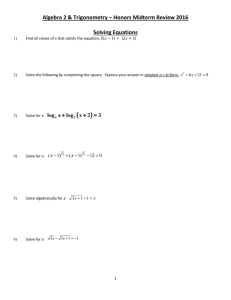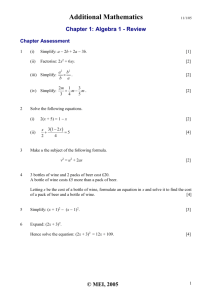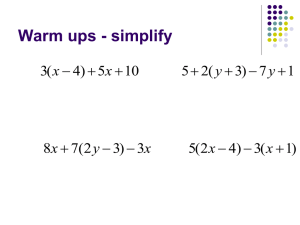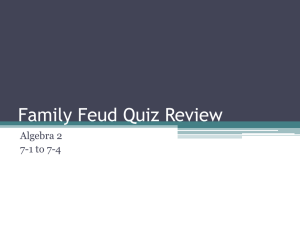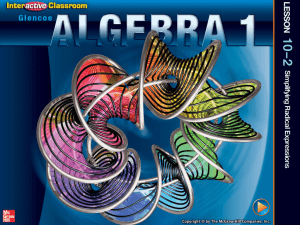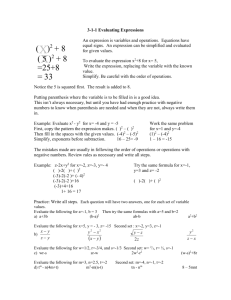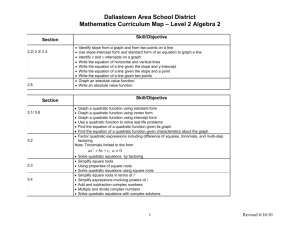Geometry Midterm Study Guide
advertisement
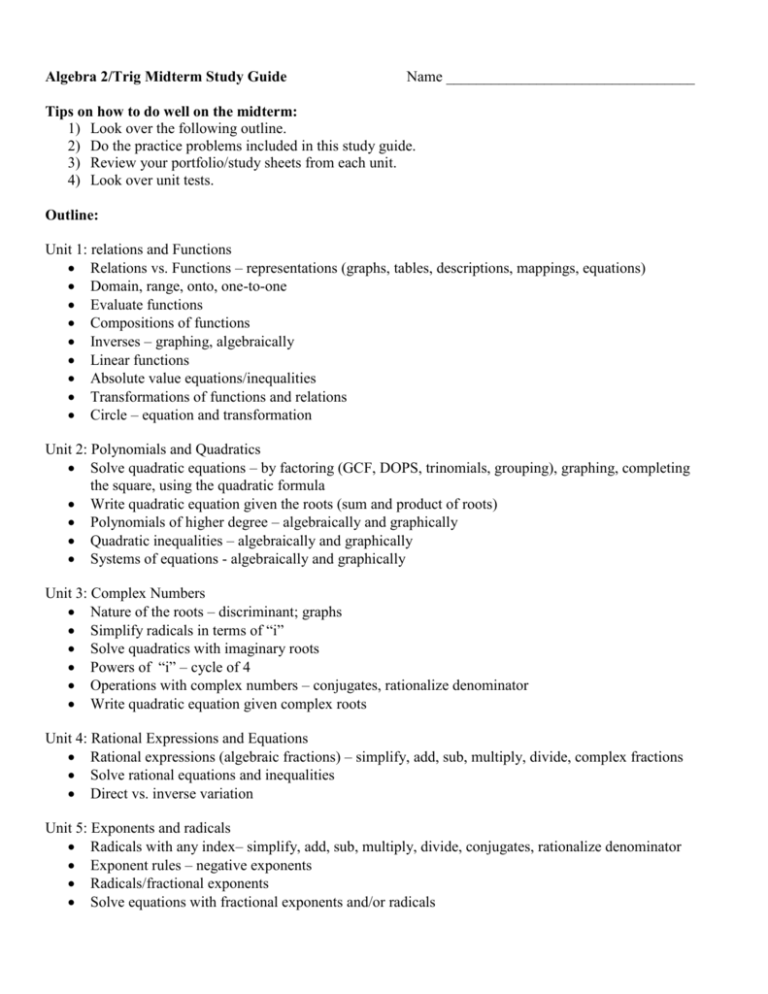
Algebra 2/Trig Midterm Study Guide Name _________________________________ Tips on how to do well on the midterm: 1) Look over the following outline. 2) Do the practice problems included in this study guide. 3) Review your portfolio/study sheets from each unit. 4) Look over unit tests. Outline: Unit 1: relations and Functions Relations vs. Functions – representations (graphs, tables, descriptions, mappings, equations) Domain, range, onto, one-to-one Evaluate functions Compositions of functions Inverses – graphing, algebraically Linear functions Absolute value equations/inequalities Transformations of functions and relations Circle – equation and transformation Unit 2: Polynomials and Quadratics Solve quadratic equations – by factoring (GCF, DOPS, trinomials, grouping), graphing, completing the square, using the quadratic formula Write quadratic equation given the roots (sum and product of roots) Polynomials of higher degree – algebraically and graphically Quadratic inequalities – algebraically and graphically Systems of equations - algebraically and graphically Unit 3: Complex Numbers Nature of the roots – discriminant; graphs Simplify radicals in terms of “i” Solve quadratics with imaginary roots Powers of “i” – cycle of 4 Operations with complex numbers – conjugates, rationalize denominator Write quadratic equation given complex roots Unit 4: Rational Expressions and Equations Rational expressions (algebraic fractions) – simplify, add, sub, multiply, divide, complex fractions Solve rational equations and inequalities Direct vs. inverse variation Unit 5: Exponents and radicals Radicals with any index– simplify, add, sub, multiply, divide, conjugates, rationalize denominator Exponent rules – negative exponents Radicals/fractional exponents Solve equations with fractional exponents and/or radicals Practice Problems: Explain your choices!!!!!! Unit 1 1. Which graph represents a function? 1) 3) 2) 4) 2. On the accompanying diagram, draw a mapping of a relation from set A to set B that is not a function. Explain why the relationship you drew is not a function. 3. Which function is not one-to-one? 1) 2) 3) 4) 4. Which diagram represents a one-to-one function? 1) 3) 2) 4) 5. If the domain of 1) 2) 3) 0 4) 7 is , which integer is not in the range? 6. What is the domain of 1) 2) 7. If and 8. If , find 9. If 10. If and and ? 3) 4) , find the value of . , find , find . . . 11. If and , find . 12. The accompanying graph is a sketch of the function y = f(x) over the interval 0 x 7 . What is the value of ( f f )( 6) ? 13. Given: If the inverse of the set is , which statement is true? 1) A and 3) A is a function and are functions. is not a function. 2) A nor 4) A is not a function and are not function. is a function. 14. If a function is defined by the equation function? , what is the equation that defines the inverse of this 15. The function, f, is drawn on the accompanying set of axes. On the same set of axes, sketch the graph of , the inverse of f. 16. The graph below shows the function . Sketch -f(x+2)2+4. 17. What is the solution set of the equation 1) 2) ? 3) 4) 18. Find the solution set of the equation 19. What is the solution set of the inequality 1) 2) ? 3) 4) 20. Which graph represents the solution set for the expression 1) 2) 3) 4) ? Unit 2 21. Find the sum and product of the roots of the equation 22. For which equation does the sum of the roots equal . and the product of the roots equal ? 1) 2) 3) 4) 23. Write a quadratic equation with the roots and ? 24. Factor completely: 25. Factor: a 2 a a 2b ab 26. Factor: 27. Factor: 28. Factor: 29. Solve algebraically: 30. Solve by completing the square, expressing the result in simplest radical form. 31. The roots of the equation 1) Imaginary 2) real, rational, and equal 3) real, rational, and unequal 4) real, irrational, and unequal are 32. The roots of the equation 1) Imaginary 2) real, rational, and equal 3) real, irrational, and unequal 4) real, rational, and unequal are 33. Which graph represents a quadratic function with a negative discriminant? 1) 2) 3) 4) 34. The roots of a quadratic equation are real, rational, and equal when the discriminant is 1) 2) 2 3) 0 4) 4 35. Which graph best represents the inequality 1) 2) ? 3) 36. What is the total number of points of intersection in the graphs of the equations 37. Solve the equation 38. Solve: algebraically for all values of x. (Find 4 roots.) 4) and ? 39. The graph of is shown at the right. Which set lists all the real solutions of 1) 3) 2) 4) ? 40. A spider is traveling up and down a cord in a way that can be modeled by the quadratic equation h( x) 8x 2 56 x 5 , where h(x) is the height of the spider (in inches) from the base of the cord at time x (in minutes). Answer each question below. If necessary, round answers to the nearest tenth. (Remember: In order to get full credit, you MUST show how you solved each question. If you used a graph or table from your calculator, you must reproduce the graph or table on paper. I have to be able to tell exactly how you solved each problem.) a) b) c) d) Sketch the graph Evaluate h(3) and interpret in words what it means. At what time is the spider at its maximum height and what is that maximum height? What is the time interval that the spider is at least 53 inches from the base of the cord? Unit 3 41. What is the sum of and 42. What is the product of ? and , expressed in simplest form? 43. Express in simplest form, 44. Mrs. Donahue made up a game to help her class learn about imaginary numbers. The winner will be the student whose expression is equivalent to . Which expression will win the game? 1) 2) 3) 4) 45. When simplified, 1) I 2) 3) 4) is equal to 46. The expression 1) 2) 3) 4) is equivalent to 47. Melissa and Joe are playing a game with complex numbers. If Melissa has a score of a score of , what is their total score? 48. What is the product of 49. If 50. Simplify: , find and ? and Joe has 51. Fractal geometry uses the complex number plane to draw diagrams, such as the one shown in the accompanying graph. Which number is not included in the shaded area? (1) –0.5i (2) –0.9 (3) –0.5 – 0.5i (4) –0.9 – 0.9i 52. If z1 3 2i and z2 4 3i , in which quadrant does the graph of ( z2 z1 ) lie? Unit 4 53. Simplify: 54. Express in simplest form: 55. Express in simplest form: 56. What is the sum of and ? 57. Expressed as a single fraction, what is ? 58. Expressed as a single fraction, what is ? 59. Simplify: 60. Simplify: 61. Solve for x: 62. What is the solution set of the equation ? 63. In the table below, y varies inversely as x What is the value of t? 64. To balance a seesaw, the distance, in feet, a person is from the fulcrum is inversely proportional to the person’s weight, in pounds. Bill, who weighs 150 pounds, is sitting 4 feet away from the fulcrum. If Dan weighs 120 pounds, how far from the fulcrum should he sit to balance the seesaw? Unit 5 30 65. Simplify: 5 64 x y 11 2 4 66. Simplify: 6 x x 3 67. Simplify: 3 3 27 x5 4 x3 x 2 10 15 2 68. Simplify: (64 x y ) 5 69. If 70. If , what is the value of , then ? is equal to? 71. What is the value of the expression when ? 72. Simplify: 73. Simplify the expression 74. In simplest form, express and write your answer using a positive exponent. with no negative exponents. 75. The expression 1) , is equivalent to 2) 3) 4) 76. When simplified, the expression 1) 2) 3) 4) 77. Solve: 1 4 5 x 1 11 78. Solve: 2( x 6) 3 4 54 is equivalent to

